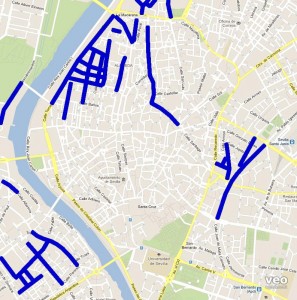A frequent question of apartment guests who are travelling by car, whether their own or a rental, is about the possibility of free on-street parking in Seville. Having to pay for a nice apartment and good food every day during your holidays, it is natural that they want to economise on the “accommodation” of the car…
In a previous post, we discussed the different options for affordable garage parking. This post is part 2 on the parking theme: How and where to park for free on the street.
On the map here we have marked streets inside the historic centre and around where you may be able to find a parking space.
1. Safety – Is it safe to leave my rental car on the street?
In our opinion, the answer is “yes”, though with some reservations. Although theft of and from cars has dramatically decreased over the last 15 years, and is not a big risk in the centre of Seville and its immediate surroundings, it is of course, still important not to leave bags or valuables in your car, and as far as possible not to leave any visible “signs” that it belongs to a foreign tourist (though admittedly this is tricky if you come in your own car with foreign license plates).
In many areas, there are people who hang around empty parking spaces, intent on “helping” you park your car or indicating a free space for a fee. In Spain, they are called “aparca-coches” (car-parkers) or more frequently “gorilas”. As you may deduce from the latter expression, Spaniards do not place much value on this service. In fact in Seville, the local police are trying to eradicate the practice, though without much success so far. There are still many of these people on the streets, but at least their attitude when asking for money has become less aggressive. In terms of the car, there is little or no risk, even if you don’t pay. Legal car-parkers, who have a badge and will issue you with a ticket, are few and far between, and you’re pretty unlikely to see one!
Another issue, related to security, is the possibility of the car being scratched or damaged by inconsiderate or inept drivers while parked on the street. This IS a risk which you have to consider, especially bearing in mind the standard policies of car rental companies regarding damage to their cars. In southern Spain, car drivers are often careless when parking in front of, or behind, your car. Bumping the other car (parking “by touch”), and even pushing to increase the parking space, is common practice. Double parking is also a frequent problem, though generally the car is left with the hand-brake off in case you need to push it out of the way if you have been blocked in. On narrow streets within the centre, be aware of the width available for passing traffic, as wider vehicles might scratch the side of your car when.
2. Neighbourhoods – Where can I find a space?
As previously mentioned, it is extremely difficult to find a free space in the centre, but it’s not impossible.
Macarena neighbourhood: around calle Feria, inside the historic centre, and outside, north of calle Resolana, towards the Macarena hospital.
San Vicente neighbourhood: mainly on calle Torneo (which goes alongside the river), and some of the smaller side streets towards the Alameda de Hercules.
Santa Cruz neighbourhood: virtually impossible, so not recommended. Try east of calle Recaredo (outside the historic centre).
Triana neighbourhood: Calle Pages del Corro and towards the west.
3. Time – When are your chances best?
The best time to find parking space on the street is early morning (08:00-08:30), lunch time (14:00-16:00 hours) and after 8.00pm, when people leave the city centre. Generally, your chances are much better at the week-end. You might consider paid public garage parking on arrival, and then look for a street parking space later once you’ve unloaded your luggage, or on the following day.
4. Restricted areas – Where is it forbidden to park?
There are no general parking restrictions in the centre of Seville, which means you can park anywhere where it is not explicitly forbidden by traffic signs, or if you’re in a “zona azul” (blue zone), identified by traffic signs and blue lines on the road, which are paid meter parking only on weekdays and Saturdays (check times on the signs). We recommend being observant. Sometimes, you will see cars in a line or double parked in restricted areas. However, these will be locals who know the rules. Do not park there! Here’s an example: next to the food market on calle Feria there is an unloading bay. In the afternoons, the market is closed and the bay unoccupied, but a truck comes to hose down the market stalls, and your car will get towed away immediately if the space is needed for the truck.
If the police tow your car away, they will leave a sticker on the ground where the car was parked. It will be taken to the pound on Avenida Blas Infante, next to Parque de los Principes in the los Remedios neighbourhood, where it can be collected once you’ve paid the fine (around the 200€ mark).
Hopefully this has not been too discouraging 😉 and as a counter-balance, a final word on Spanish police: we have found them to be more lenient than central Europe police forces. This is due to the fact that Spanish administration, in general, is less likely to act on its own initiative. They are more likely to react when there is a specific complaint from somebody, as in the market example above.
